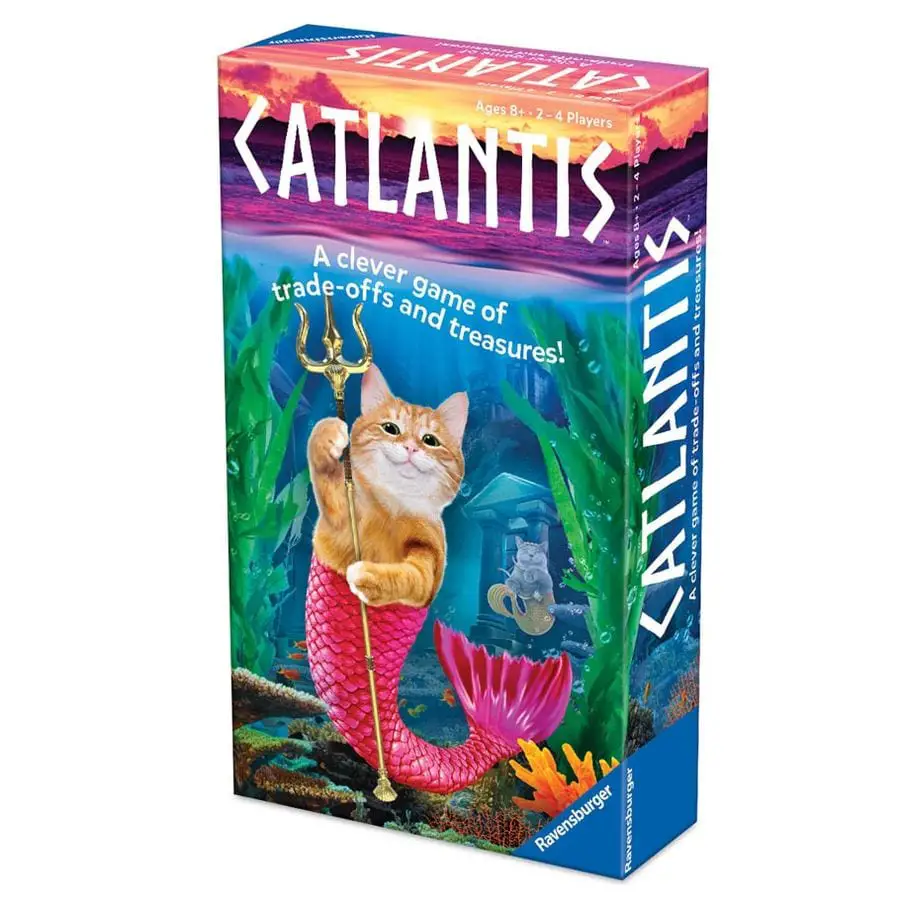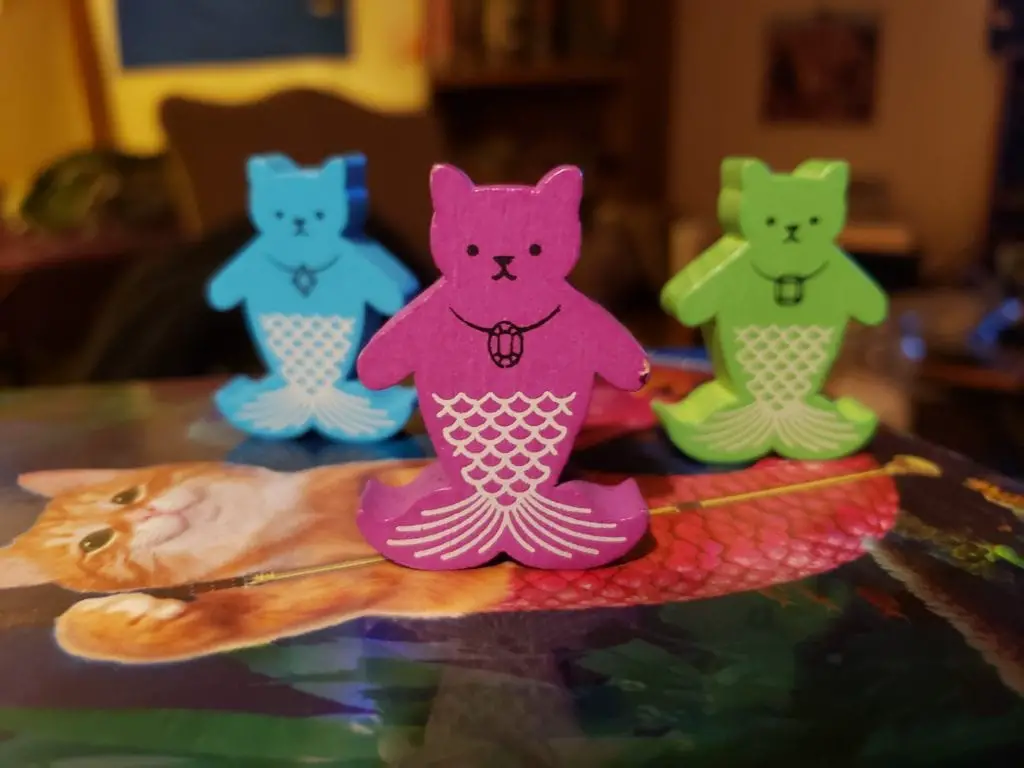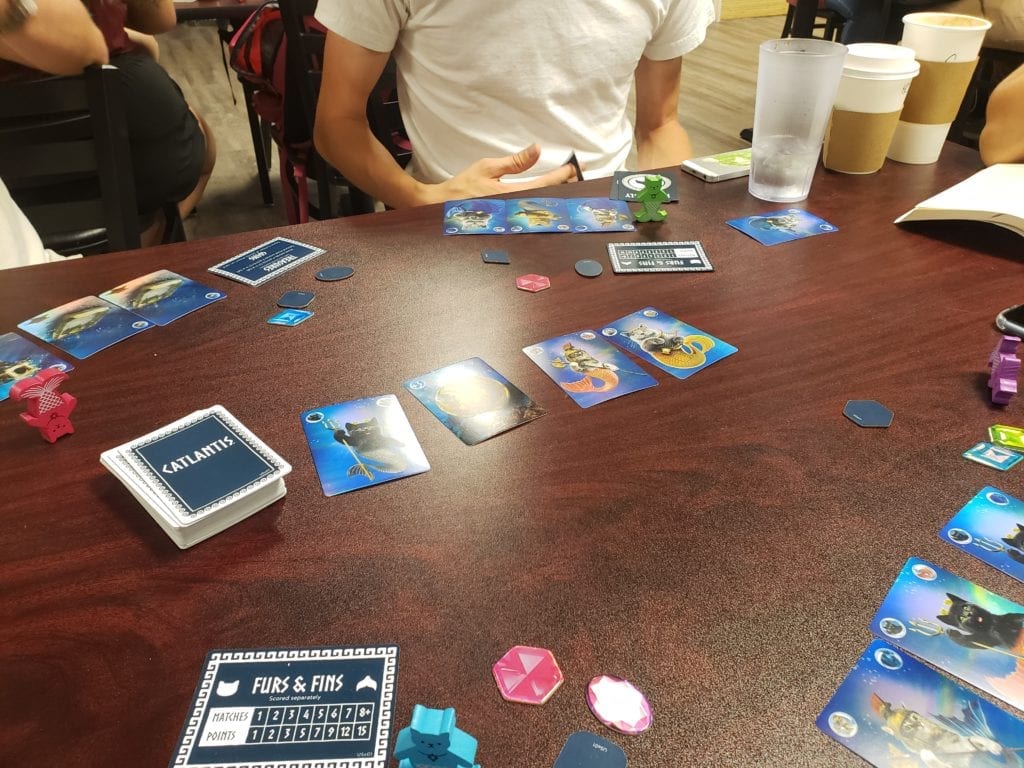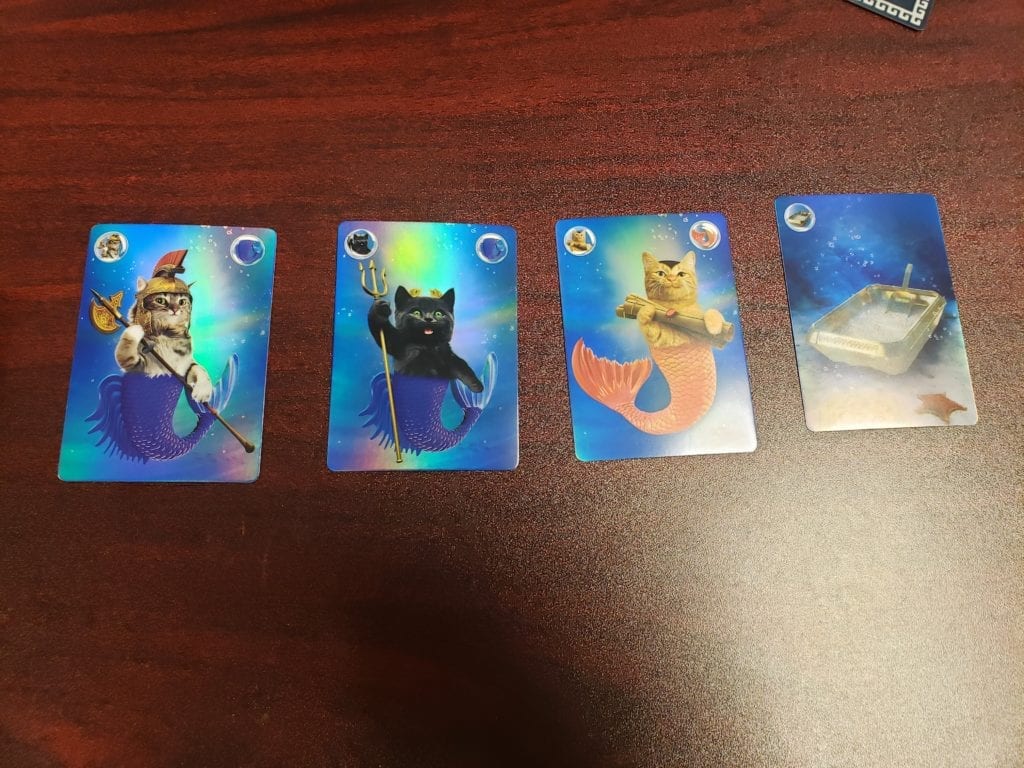Everybody likes cats, or it at least seems that way considering how many games have come out this year themed around our furry feline friends. If I tried to list them all, which currently sit at around thirty by my count, we’d probably be here all day. Since it is, after all, National Cat Day here in the US, it seems appropriate to feature one of those games aimed at the cat-lover inside all of us: Catlantis.
One of the GenCon releases from German publisher Ravensburger, Catlantis is another product of their very successful relationship with the design collective Prospero Hall (Villainous, Jaws). Like most Prospero Hall games, it’s a lower weight game that puts a big emphasis on theme and production value. It was a little overshadowed by other Ravensburgee releases at GenCon like Horrified and Jaws, but does it really deserved being overlooked like it’s been? Let’s find out.
What’s In The Box?

The main visual feature of this game, which is evident on almost every component and the box itself, is foil. This is a shiny, shiny game. It really plays into the game’s theme quite well, as it evokes not just the ocean setting but also also is the exact kind of reflective material that a cat would love. The best use of it is probably on the MerCat cards, where the scintillating scales of their tails shimmer on the tabletop. The outside of the box, as you can see above, is quite eye catching and immediately reveals how cute the game is. The interior of the box is shaped to hold all the cards and is printed in that lovely “santorini blue,” complete with the little wave pattern you see at every Greek restaurant.

The star of the show is obviously those MerCat cards, which each having a different combination of cat torso and fish tail that reflect the “Fin Families” and “Fur Orders” that the game centers on. There’s also the coins, worth flat amount of points, and the treasures. These are maybe the funniest part of the game, as they continue the mixing of Atlantis with cats by featuring “The Sacred Litter Box,” “The Golden Laser Pointer,” and the “Catropolis,” which is The Acropolis if it were a scratching post. They all have a photographic but cartoony look that is incredibly endearing and sweet. The game’s “pieces,” such as they are, are the foil gems that represent each player while “betting” and the MerCat figures that player’s use to denote who is who. These figures are all wood and painted quite vibrantly, but are largely just there to keep track of who is associated with which color. They even each wear a necklace that shows the gem associated with each player, again to help keep track of who goes to what. Older players won’t really have a need for them, but they’re well made and quite cute so they’re not hurting none.
How’s It Play?

If you’re looking for a complicated game, filled with strategy, tactics, and an elite level of challenge…this is not the game for you. But you know what those big high falutin’ games don’t have? Adorable cat mermaids. The main conceit of the game is that the different castes of Catlantean society have broken their truce and decided to battle for control of the city. Each player will belong to a “Fur Order” i.e. monarchs, musicians, muses, scholars, or soldiers; and a “Fin Family,” of the Atlantic, Pacific, Indian, Arctic, and Southern oceans. All that functionally means is you’ll have a cat half and a color of tail to keep an eye out for as the different mercats and treasures are revealed. It’s a secret though, and you musn’t let other players see what your goal is.

Each round, four Catlantis cards are turned over in front of the players, some of which are MerCats and some which are treasures or coins. Players then use their offering tokens, the little shiny jewels that represent the other players, to offer two of the cats to that player, with you taking the one your opponent doesn’t pick. There’s some strategy here, as you can’t give away your goal but you also have to try do deduce the other player’s strategy. You also can’t just screw yourself into a bad choice. You have to offer to every other player, and the round ends when every player has turned over all of their offering tokens. The game ends when the deck runs out, and players immediately begin scoring. Coins are worth a flat number and treasures give points to players who have the most of each kind, and to the player with the second most (ties for the most get slightly less points, and ties for second get nothing). The MerCats are scored based on a scorecard each player has, with the furs and fins scored separately and matched MerCats scoring on both! The winner with the most points is declared the victor and “Grand Purr-Bah” of Catlantis!
The Verdict

Like I said before, this isn’t really a game for you hardened card game players. And, truth be told, Catlantis is not really a game for adults at all. There isn’t a lot to the game and the strategy is pretty damn simple. Even when you get it, you don’t really get a tactical advantage by knowing what the other person is going to be going for. It’s not breaking new ground in the genre, either, but it would actually serve as a very good entry point for new players or kids into more complicated strategy card games. It also is low stakes enough that you can kind of play it while you talk or do other stuff, like some more traditional card games.
But, honestly, that’s not really the draw of this game. The draw of the game is in the presentation and the theme, and it really knocks those out of the park. Anybody with even some soft spot for cats is going to find this game at least worth one play, just for all the cute cats and silly puns used in the game. The artwork is cute and very pleasant, the foil used throughout the game really makes it pop on the shelf or on the table. Overall, it’s a very pleasant little game that knows exactly what it is and what it’s supposed to do, and it does that superbly.
You can pick up Catlantis on Amazon, where it retails for $19.99.
[rwp_box id=”0″]
__________________________________________________________________________________
Images via Ravensburger
Special thanks to Ravensburger for the copy of Catlantis used in this review

